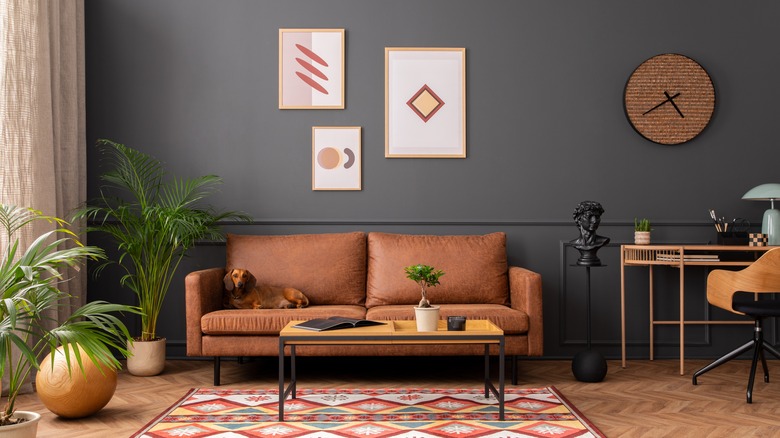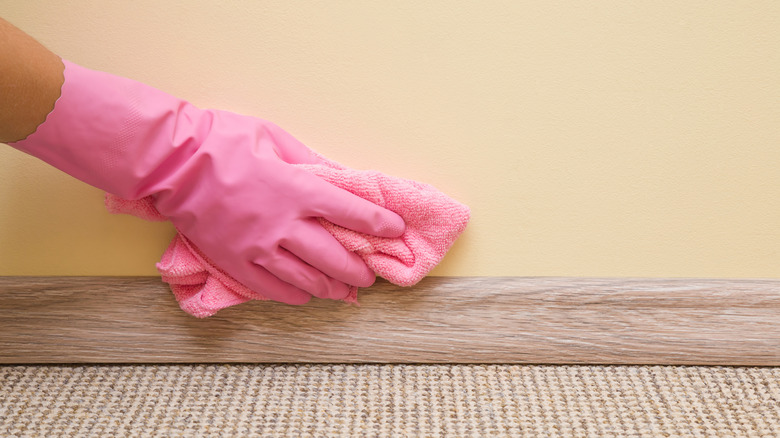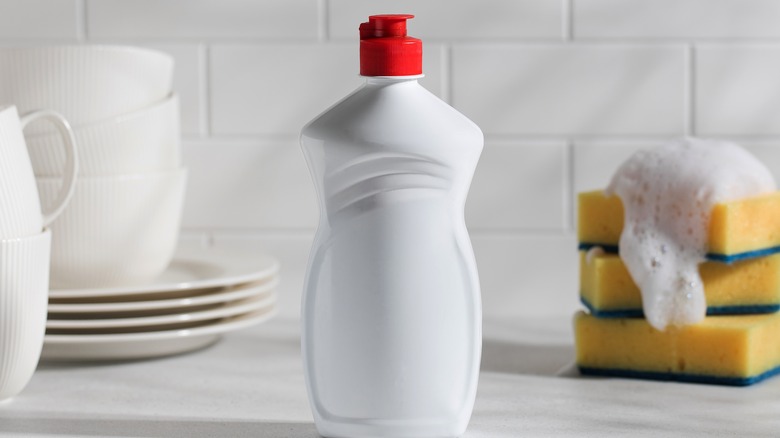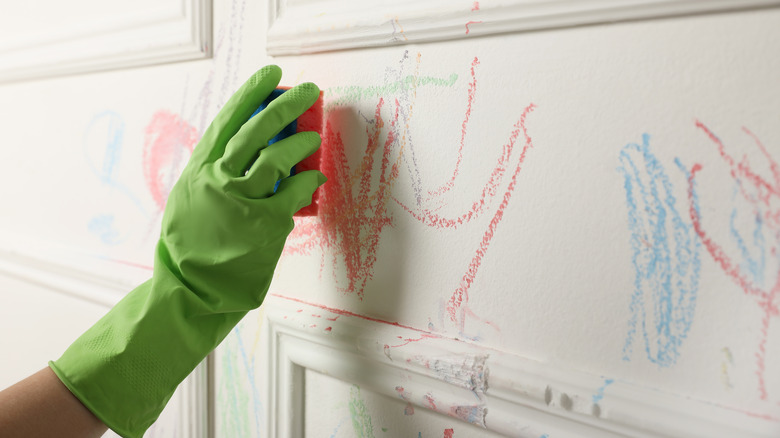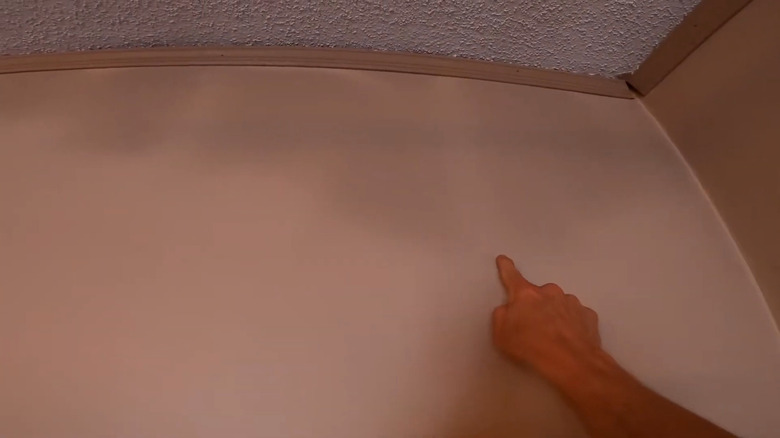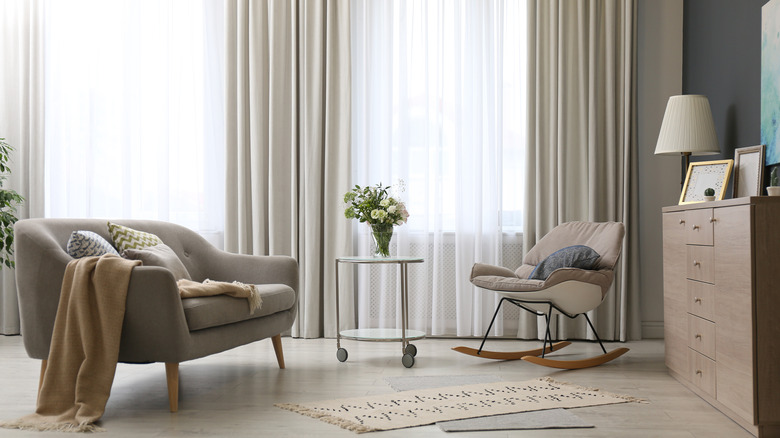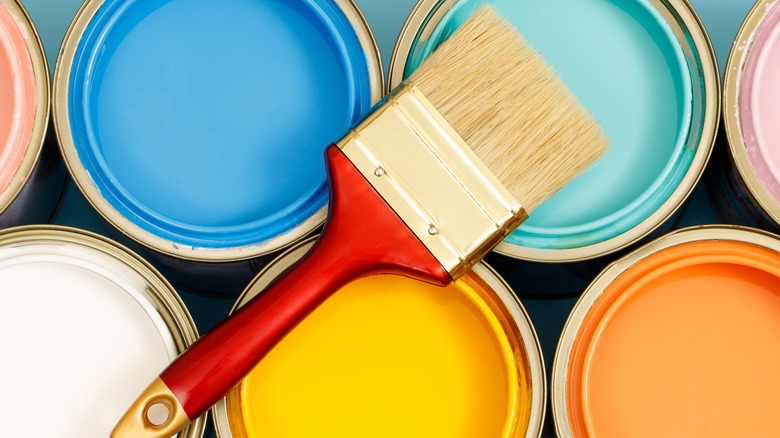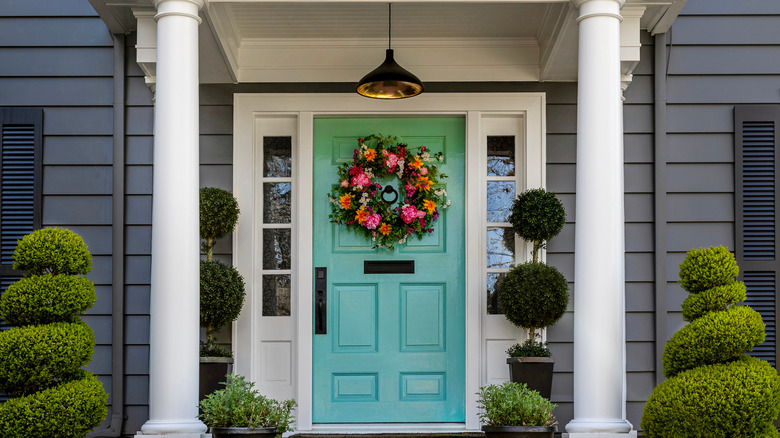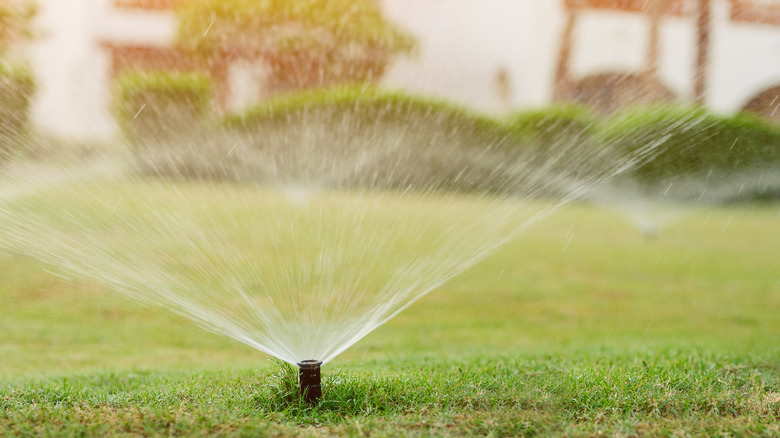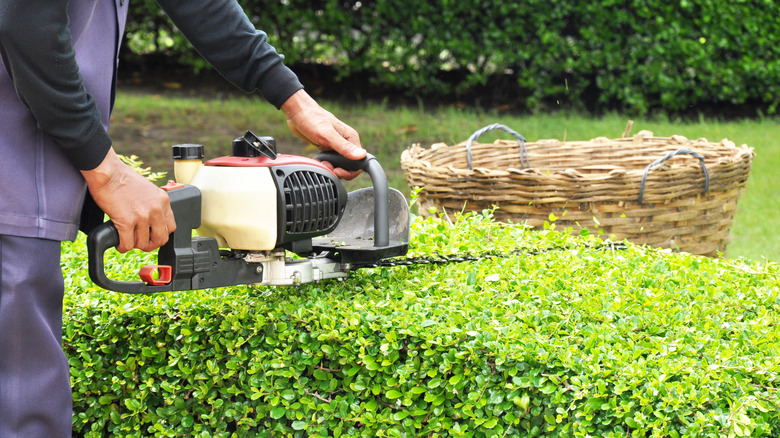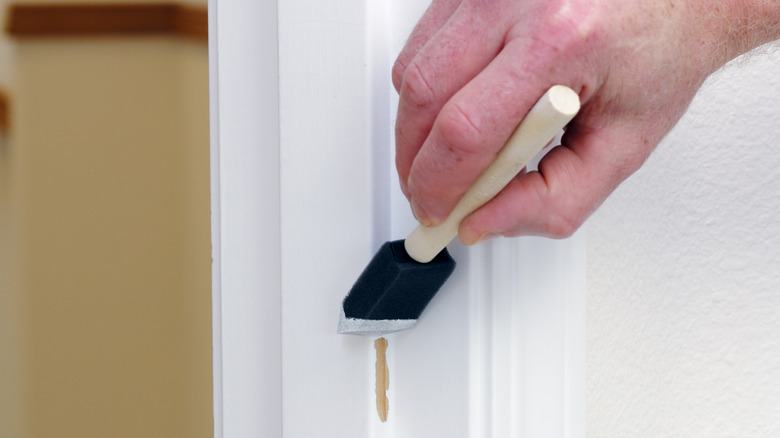Keep Your Paint Looking Bright And Fresh With These Essential Tips
We may receive a commission on purchases made from links.
You invest considerable time, money, and effort in the interior and exterior paint jobs around your home. For this reason, you want the pristine appearance of fresh, new paint to last as long as possible. While paint does age over time, there are plenty of steps you can take to keep it looking bright and clean well into the future.
The key is to keep up with maintenance. If you let dust and grime build up for months without wiping the walls clean, it will begin to permanently dull the paint's appearance. You want to chase down any scuff marks or rogue stains, and do so using the best cleaning products for the job. For example, using something too harsh can take off a layer of paint or dull its sheen. While it might sound like a lot of work at first, it's completely manageable and can become a part of your monthly or quarterly cleaning routine. Here's what you need to do.
Dust your interior walls regularly
You're familiar with the need to dust your furniture regularly. But did you know that your walls also need occasional dusting? Like on furniture and floors, dust builds up on your painted walls, eventually hiding the luster of even the most radiant paint job. The longer you leave grime and cobwebs on your walls, the more permanently they attach to the paint. To keep the color looking fresh, dust your walls and remove cobwebs once a month.
An efficient way to clean your painted walls is with the soft brush attachment of your vacuum cleaner. While vacuuming the floors, you can easily attach the soft brush and give the walls a quick dusting. If you have trouble reaching the high portions of the walls, try using a microfiber cloth or an old towel draped over the head of a broom. This is a convenient way to reach the cobwebs that form in high corners where the wall meets the ceiling. Alternatively, you can dust your walls using a flat-head mop with a removable microfiber dusting cloth.
Use the right cleaning products
Although you dust your walls every month, it's a good idea to thoroughly wash them at least once a year. When it's time for this type of deep cleaning, you'll need to use the right products to preserve the beauty of your painted wall color. Paint finishes in the flat, eggshell, and satin categories require extra care, as harsh cleaning products and methods can remove the paint and leave behind unsightly streaks. For these finishes, you can use warm water and a few drops of dishwashing liquid. Start by vacuuming or dusting the wall to remove loose debris. Then, be careful not to scrub the wall vigorously. Instead, dip a microfiber cloth in the soap-and-water mixture and wring it out thoroughly. Wipe the wall gently to remove dust and dirt without removing the paint. Dry it with an old towel.
Semi-gloss and high-gloss paint finishes hold up to more vigorous scrubbing and products formulated for degreasing. These types of paint finishes are frequently found in kitchens and bathrooms. Oil-based paint holds up to scrubbing more readily than latex paint, but some latex paints are specially formulated as washable paints. It all depends on what the can reads. It's a good idea to test any cleaning solution in an inconspicuous place before applying it to the entire wall. Additionally, you should use non-abrasive soft cloths or sponges when cleaning your painted walls.
Act quickly to remove smudges, scuff marks, and stains from painted walls
Inevitably, life happens, and your painted walls will get their share of scuffs and stains over time. When your walls show undesirable marks, it's important to act quickly. The longer the stain stays on the wall, the more permanent it becomes. In most cases, you can remove stains and smudges with a soft cloth and a mixture of warm water and dishwashing liquid. The key to spot-cleaning success is to wring out the excess water and gently wipe the affected area with the cloth, carefully avoiding harsh scrubbing. When the smudge is gone, rinse with clear water and dry the wall with a towel.
If mild soap and water do not remove the smudge, you can rub the spot gently with a Magic Eraser that has been moistened with water. However, it's important to test the sponge in an inconspicuous place before proceeding with this method. Otherwise, you might damage the sheen.
For crayon marks and scuffs on your painted walls, you can apply a DIY paste of baking soda and water. Gently scrub the spot with the paste, using a circular motion. Then, wipe with a damp cloth. Alternatively, stubborn stains on your walls might require a commercial wall-cleaning solution, such as Zep Foaming Wall Cleaner. Be sure to test any wall cleaner in a seldom-seen area before applying it to your wall.
Keep furniture, candles, and decor items away from painted walls
Any item that touches your wall over a long period of time can leave a dark stain or mark. This includes picture frames and mirrors that lean against the walls as well as furniture pieces that get shoved up against the wall on a regular basis. To preserve the beauty of your paint color and finish, it's best to place your furniture at least a few inches away from the wall. Avoid using decor pieces that lean, opting to hang artwork and mirrors with traditional picture hooks or Command Strips.
Also, be aware of the black soot from candles and oil lamps. It can settle on your painted walls and ceilings, damaging the paint color and finish. Place these items on tables away from walls, and keep them away from drafts.
If you notice black soot marring your color, gently rub the area with a dry-cleaning sponge, also known as a chemical sponge. This is a specialized type of sponge for removing black soot. Alternatively, you can wipe the area with a microfiber cloth dampened with rubbing alcohol.
Take steps to avoid ghosting on your interior walls and ceilings
You might have noticed faint black or gray streaks on the walls and ceilings in the vicinity of air ducts, vents, and baseboard heaters. This phenomenon is known as "ghosting" or "thermal tracking," and it can obscure the color and sheen of your paint. Ghosting is caused by the circulation and condensation of dirty air that contains soot and dust from a number of sources. These might include cigarette smoke, burning candles, wood-burning fireplaces, cooking oils, or pet dander.
Use a highly diluted solution of bleach and water along with a soft cloth to clean the ghosting marks on painted walls and ceilings. It's a good idea to wear rubber gloves and to ventilate the area as much as possible. In some cases, it might be wise to call a cleaning company whose technicians know how to remove the smudges caused by ghosting.
If you observe considerable dark smudging, you will need to take steps to fix insulation problems, eliminate cold spots, and remedy the causes of excess humidity and condensation in your home. Additionally, you should clean your air ducts and vents and make a habit of changing your air filters regularly. These steps will help reduce condensation and ensure clean air circulation in your home.
Use curtains to stop fading
When you're ready to paint your interior walls, the color selection process takes time and effort. After careful consideration, you find the perfect color, only to find that it fades in a few years. Suddenly, you realize that the rich and vibrant color you loved has become dull and lifeless. Sunlight is the biggest culprit in fading interior paint. Because of this, you can help your wall paint to stay fresh if you shade the room with blinds or curtains when the sunlight is strong or when you're not in the space.
You might note the seasons and times of day when the sun shines into a room at its brightest angle. Then, take steps to shade your painted walls at those times. Many manufacturers of window shades and blinds offer smart, programmable choices that allow you to close the window coverings even when you're not at home. The control options include an app on your phone, a programmable remote, or a voice assistant such as Alexa, Siri, or Google Assistant.
For the best results, choose curtain and window-shade fabrics that block the sun's ultraviolet (UV) rays. Curtains lined with metallic foam backings or polyester linings reflect light and keep the sun's rays from fading your painted walls. Additionally, thicker and more tightly woven fabrics offer greater protection than sheer or lacy options.
Choose the right paint finish and brand
When choosing paint for your interior walls, the color seems to be the most important factor. But, the quality and finish of the paint contribute a great deal to whether the color is susceptible to fading from sunlight. Matte, flat, and eggshell paint finishes absorb sunlight, causing them to break down faster. The result will be faded color. On the flip side, satin and semi-gloss finishes reflect sunlight, allowing them to stay fresh for longer periods. If sunlight pours into your living space, you might choose a satin finish for the walls and a semi-gloss finish for the trim. These types of paint will stay vibrant longer than other choices.
In addition to your paint's finish, the product quality affects whether the color becomes faded and dull over time. High-quality paints contain superior pigments and binders to ensure that the paint color resists fading and keeps its vivid appearance. Although higher-quality paint costs more, shopping for the best and most durable option will pay off in the long run.
Keep your exterior paint from fading
Whether you make it a DIY project or call in the pros, painting the exterior walls and trim represents a sizable investment in the long life of your house. In addition to providing curb appeal, exterior paint protects the structural integrity of the building. Fortunately, you can take steps to keep the paint job looking like new.
First, it's important to choose exterior paint in colors and finishes that resist fading. Bright colors like red, orange, dark blue, dark green, and yellow are prone to fading due to their propensity for absorbing sunlight. Alternatively, inorganic pigments like brown, beige, and tan resist fading. Secondly, it's important to select a paint finish that reflects sunlight, rather than absorbs it. Higher-gloss paints are less prone to fading due to their reflective properties. You might choose a satin or eggshell paint finish for the exterior walls, along with a semi-gloss finish for the trim. Keep in mind that oil-based paints generally fade faster than high-quality acrylic latex paints.
Wash your painted exterior walls once a year
In addition to sunlight, your exterior paint can look aged and dull due to high heat, humidity, and harsh weather conditions. Additionally, dust and pollen collect on the outdoor surfaces over time. As a practical step, you should wash your walls and trim once a year. Start by sweeping away cobwebs and obvious debris. Then, wash the painted surfaces with a mild, diluted detergent, a garden hose, and a soft, long-handled brush.
Some people prefer using a pressure washer to clean the painted exterior surfaces of their homes. If you choose this method, take care to use a 40-degree nozzle; it delivers a wide spray with reduced pressure. Avoid nozzles with 0-, 15-, and 25-degree designations, as they create such a strong jet of water that it can remove the paint from your walls. Whether you use a pressure washer or a regular garden hose, cleaning the dirt and dust from your exterior paint will help it to look bright and fresh as long as possible.
Adjust your sprinklers to avoid damaging the home's exterior paint
A sprinkler system is an ideal way to maintain a thriving lawn and landscape, but it can be detrimental to your home's exterior paint job. When water from a sprinkler hits the outer wall of a house, it fades the color and wears away the paint. With repeated water spray over time, the exterior paint can form bubbles and start to peel. This situation damages the exterior coating and weakens the paint's moisture barrier that protects your home's structure.
The problem is exacerbated when a sprinkler head is clogged or positioned incorrectly so that it delivers a strong jet of water to one section of a painted wall. For this reason, it's crucial to monitor your sprinkler heads and adjust them so that the water spray reaches your grass and plants but not your home's exterior walls. You might consider planting your lawn and shrubbery a short distance away from the house so that you can water them without sacrificing the integrity of the exterior paint job. To eliminate the need for water spray right next to your home, you can fill the area adjacent to your exterior walls with rocks.
Keep shrubbery and trees pruned back away from painted exterior walls
While it's helpful to provide shade that reduces the color-fading effects of heat and sunlight on exterior paint, it's wise to minimize contact with trees and shrubs. Especially in windy conditions, the branches can scratch the paint, causing failure in the paint's moisture barrier that results in peeling. For this reason, it's a good idea to plant and prune your landscape to keep it from touching your home's exterior walls.
The growth of fungus on outdoor painted surfaces presents a problem for your home's curb appeal as well as the longevity of the exterior paint job. Mold and mildew flourish in dark, moist environments, and their growth on your home's exterior walls damages the paint, leading eventually to structural damage. The foliage from plants and trees retains moisture and blocks sunlight, creating the perfect conditions for mold and mildew growth. For this reason, you'll want to keep trees and shrubbery trimmed back from your painted outside walls. Additionally, giving the walls their annual cleaning will be easier if landscaping does not crowd up against your home's exterior painted surfaces.
Do touch-up painting when necessary
Normal wear and tear means you'll occasionally need to do touch-ups on your paint jobs. This means you'll paint small sections of a wall to hide chipped or worn spots without repainting the entire thing. When the time comes, it's necessary to match the color as closely as possible. Hopefully, you have some leftover paint from the original project, allowing you to blend paint from the same batch to achieve a seamless appearance. If not, you'll need to match both the color and the finish with a new can. Keep in mind that two paints of the same color can look completely different if their finishes are not the same.
As you carry out the touch-up job, you'll want to match the texture of the original paint. This means that you'll need to use either a roller or a paintbrush to produce a texture that does not deviate from the wall's current appearance. Take into consideration the nap of the roller or the size, angle, and bristle type of the paintbrush.
When you do touch-up painting, it's best to apply the new paint with a light touch. Use only as much paint as you need to cover the affected area and feather it out to blend with the existing paint. If necessary, you can add a light second coat to complete the job.
